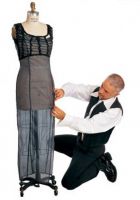Fake - the configuration of the part is determined on the mannequin or on the customer.
It is often used for the manufacture of collars and draperies of complex configurations.
Until the XNUMXth century, it was the main one, and today we are witnessing its revival in haut couture wedding and evening dresses.
Settlement and measuring - cutting was carried out after taking measurements.
The method improved over time, because each tailor came up with his own system, which he followed.
It should be noted that in its "pure form" the calculation-measuring method no longer exists, since some elements of the calculation-proportional and calculation-analytical methods have been added to it.
Settlement-proportional method - existed before the 1960s and is successfully operating today.
In practice, it is a successful attempt to generalize the experience of previous generations of masters.
The disadvantage (it can be considered an advantage) of the method is that all figures are considered conditionally proportional.
Despite this, the calculation-proportional method has taken root well in individual tailoring due to the fashion for ready-made patterns.
Settlement and analytical - in fact, a somewhat complicated calculation-proportional method, which summarized the data of the huge work done by Soviet tailors.
They carried out the so-called all-Union measurement of the population.
It is used in mass production, although some details are also used by masters of individual tailoring.
The method described in my books, combines all the above methods, not excluding the dummy.
It is very close to the one used today by cutters in fashion ateliers.
The main difference is in the simplified method of presenting the material.
I have developed several new designs, but you can’t do without the classic foundations.
Classics for me are the basics of the cutter A.F. Makarenko.
I think it's worth saying a few words about tailor-made tailoring methods.
Unfortunately, none of them has found wide distribution.
For example, the "alphabet" method "Lubaks": before cutting, you need to remember a rather voluminous alphabet.
In my opinion, its distribution is hindered by an ill-conceived method of presenting material.
Voronin's mock-vest method has proven itself well in the individual tailoring of men's clothing.
Bochkareva's method is not widely used, although it is interesting.
Again, the chaotic presentation of the material and even the abundance of illustrations does not help.
Zlachevskaya's method: interesting, progressive, but I didn't like the presentation in the book.
And that's why. There are no memory markers, no returns, no intermediate drawings, no dedicated rules and schemas.
A bloated introduction and movement from "complex to complex" (you need "from simple to complex") do not contribute to memorizing such a large number of notations and measurements.
But in general, sample-free methods have not become widespread, not because of an imperfect presentation technique and not because of a mismatch between the level of complexity and preparedness of the audience.
(I assume that the reader has completed elementary school and has forgotten almost everything).
The main reason, of course, is in the psychology and physique of the users of the method - women.
But that's another question: Why do we need samples...


 Join my community on Viber...
Join my community on Viber...











